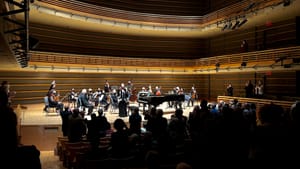Stay in the Loop
BSR publishes on a weekly schedule, with an email newsletter every Wednesday and Thursday morning. There’s no paywall, and subscribing is always free.
The keyboard, from Bach to Glass
The Chamber Orchestra of Philadelphia presents Simone Dinnerstein

Increasingly these days, classical presentations range both in era and in artistic content, and a recent luminous concert by the Chamber Orchestra of Philadelphia was especially notable in this respect. With the masterful Simone Dinnerstein at the piano and Dirk Brossé joyously commanding the podium of the Perelman Theater, the orchestra musically traveled back and forth almost 300 years.
The concert opened in the 21st century with “Strum,” a strong seven-minute work by American composer Jessie Montgomery (b. 1981). Long associated with the Sphinx Organization, which is "dedicated to transforming lives through the power of diversity in the arts," the native New Yorker was raised by socially conscious artist parents on New York’s lower East Side and trained as a violinist at Juilliard, with an NYU master’s in composition for film and multi-media, diverse interests that shape this short but expansive work.
Opening with the violas, “Strum” was originally written as a string quintet in 2006, and Montgomery expanded it in 2012 for string orchestra, heard here. The composer weaves the classical and the vernacular in a rich tapestry, using the strings’ full range (the two double basses were especially vibrant) in traditional ways that still sounded fresh. The orchestra played often in unison, sometimes bowed, sometimes pizzicato, but always with the forward-moving combination of precision and lyricism the piece demands, moving it rhythmically toward its striking conclusion.
An Astral alumna
Pianist Dinnerstein (formerly a Philadelphia Astral Artist) then entered to warm applause, going back in time for the Keyboard Concerto No. 7 in G minor (1738) by J.S. Bach (1685-1750). Adaptations are sometimes deemed lesser, but in baroque times they were common, and Bach wrote this well-known work (along with his six other concertos) first for violin, transcribing it himself for harpsichord. In a post-concert discussion, Dinnerstein noted she felt it perfectly appropriate to play on the piano, an instrument not yet on the horizon for Bach, but that the composer would undoubtedly have embraced.
Dinnerstein is a noted and highly lauded Bach interpreter, a reputation well-founded. This familiar three-movement concerto opens energetically, and the pianist tempers her dynamism with interpretive restraint that, even in sections of a delicate rubato, remains firmly within the baroque frame. The famously lyrical middle Andante movement was beautifully shaped and though punctuated by Dinnerstein’s crystalline trills and rolls, remained grounded by the beautiful low strings and rolling elegance of violins and violas. The third movement—allegro assai—was a reminder of how closely Bach’s writing can reference the dance rhythms of his time, something Brossé evidenced in his spirited conducting.
A concerto for Dinnerstein
The intermission-less concert closed with a magnificent work by Philip Glass (b. 1937) that was movingly interpreted. Glass is one of the few composers who still puts pen to paper when he’s writing, and he composed his three-movement Piano Concerto No. 3 expressly for Dinnerstein. In 2016, the pianist met Glass at his home, where she played some of his works and some by Schubert, and in 2017 (very shortly afterward, in composer’s terms) Dinnerstein premiered this masterful work, which she has since performed more than 40 times.
The first movement opens with a slightly syncopated, almost romantic, melodic line undergirded by cinematic strings almost programmatically descriptive. Throughout, the piece has the repetitive, mysterious, mesmeric quality associated with Glass, but large sections also have a striking lyricism. Built structurally on chord progressions—sometimes stacked, sometimes syncopated, sometimes arpeggiated—the work returns often to the elusive theme that creates both familiarity and a sense of longing.
Movement III (subtitled “For Arvo Pärt,” whom Glass admires) is played by the soloist almost entirely in the piano’s lower half. Its thrumming rhythms are punctuated by an insistent low C, always played by Dinnerstein sweeping her right hand up, over, and down to reach it. Mostly in unison, the strings undergird this melancholy bell-like motif. This work is surprisingly beautiful, its emotional build clearly felt by the perfectly still audience. It drifts, al niente, into silence, and the hush at its conclusion was one of the work’s most powerful aspects.
The orchestra’s 20 string players sounded exceptionally lush and rich in this lovely hall. The Perelman is a wonderful chamber music space—both for sightlines and sound—and it was great to be able to return to its warm embrace for this uplifting musical afternoon.
What, When, Where
Bach & Glass Piano Concertos. Jessie Montgomery, “Strum”; J.S. Bach, Keyboard Concerto No. 7 in G minor; Philip Glass, Piano Concerto No. 3. Conducted by Dirk Brossé. Simone Dinnerstein, piano. Chamber Orchestra of Philadelphia. $40-$104. November 7 and 8, 2021, at the Kimmel Center’s Perelman Theater, 300 S. Broad Street, Philadelphia. (215) 545-1739 or chamberorchestra.org
The Kimmel Center requires all attendees aged 12 years or older to be fully vaccinated against Covid-19. Patrons aged younger than 12 years must provide a negative test taken within 72 hours of the performance. Masks are required at all times.
Accessibility
The Kimmel Center is a wheelchair-accessible venue, and the Perelman has wheelchair seating available, as well as seating locations near the stage for blind or low-vision patrons. Personal care attendants are welcomed free of charge to accompany a patron with a paid ticket.
Sign up for our newsletter
All of the week's new articles, all in one place. Sign up for the free weekly BSR newsletters, and don't miss a conversation.

 Gail Obenreder
Gail Obenreder